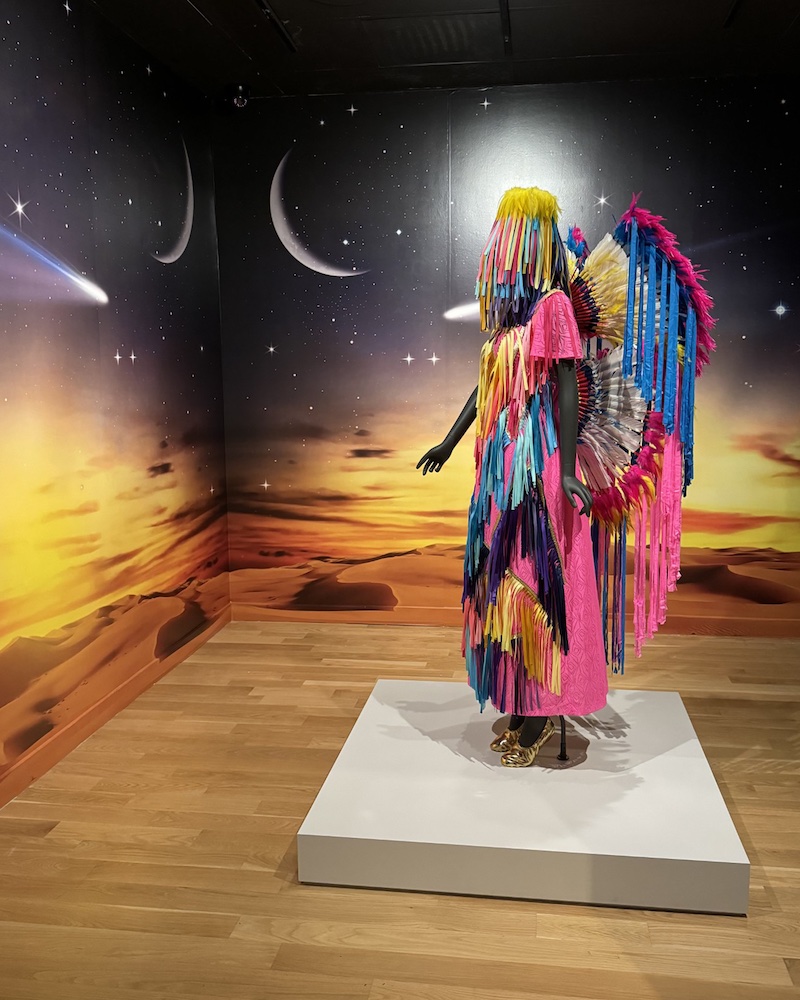Growing up on the Apsáalooke (Crow) reservation in Montana, Wendy Red Star witnessed the ways her cultural heritage was practiced, performed and integrated into the daily lives of her tribe. These customs seemed deeply disconnected from the displays in history museums that rendered her people as ancient artifacts. Spanning self-portraiture, archival imagery, large-scale installations, mixed-media collage and performance, Red Star’s practice interrogates and undermines representations of Native Americans as primitive peoples and foregrounds the dynamism of contemporary Indigenous experience. In her series Thunder Up Above, included in Future Imaginaries: Indigenous Art, Fashion, Technology, at the Autry Museum, Red Star reimagines traditional powwow regalia for a future in outer space. Red Star and I met to discuss Indigenous Futurism, sewing, Crow Fair, and the moment she realized she could paint.
Tara Anne Dalbow: Can you tell me a little about the impetus behind this series?
Wendy Red Star: These works came about from thinking about final frontiers, the West and old Western films. That led me to think about outer space, which is really the final frontier for us, and how we’ll definitely encounter other beings up there and try to colonize them as well. You know
everything has to be a little funny with me. Then I let myself run with the concept and started imagining these other beings living in outer space, and making outfits for them that were based on abstractions of powwow regalia.
TAD: Amazing.
WRS: One dress is based on a traditional men’s fancy dance bustles; another is made of sheepskin that’s an exaggerated version of what men wear on their ankles, then some very cool metallic jingle dresses, and another that’s based on women’s traditional, so a blue gown with billowing sleeves that, in Southern women’s traditional, would be this elaborate fringe that sways from their arms when they dance.
TAD: The regalia are astounding in their complexity and detail. Can you tell me a little more about your interest in wearable art?
WRS: I became obsessed with sewing when my daughter was born. It came naturally to me because I grew up watching the women in my community make traditional outfits. Sewing allows me to retain my sculpture background and think in 3-D. It’s also awesome that you can make something so large but still have it be containable. I’m also drawn to this potential for activation. I like to see them not as stagnant displays at a
history museum but as something very much still alive today.
TAD: The series you recently showed at Roberts Projects, Bíikkua (The Hide Scraper), was also focused on wearable art, or maybe utilitarian is the right word?
WRS: Yes, that is an incredible project involving research, sourcing and making painted studies of traditional rawhide cases. I didn’t think I could paint or draw until I found these cases and realized there is a whole art history of ancestral women of my community who have been painting for so long. I hadn’t seen anything like it in all my Western art classes. It’s a lost art now, so I’m trying to make an archive as a resource for my community.
Their patterns give the illusion of being symmetrical and perfect, but they’re not at all, so it’s an opportunity for me to paint the hand of the original maker and spend one-on-one time with her, seeing her decisions and choices. It’s also about giving her credit and bringing her work into the future—so many of the native exhibitions you see are focused on chiefs and warriors, not on native women.
TAD: Were you thinking about the emerging Indigenous Futurism movement when you were conceptualizing either of these series?
WRS: I wasn’t thinking about it, not explicitly, at least. As I understand it, Indigenous Futurism is about resisting the kinds of writing that try to capture us in amber. Or, like Edward Curtis, acting like he was photographing the last authentic native—and after that, we were all going extinct. There’s also maybe a desire to skip the present and move forward into the future. What I’m doing certainly fits with that.
TAD: What would a Crow Future look like to you?
WRS: For me, it’s just the traditional being carried forward. Crow Fair is over 100 years old, and it’s this miraculous event where people from all over the country meet in a town on the Crow Agency reservation. They bring their families, teepees and horses, and we camp, dance and parade in regalia for about a week. That’s what is vital to our future. That’s futurism for me.
Future Imaginaries: “Indigenous Art, Fashion, Technology” will be on view at the Autry Museum of the American West through June 2026.


